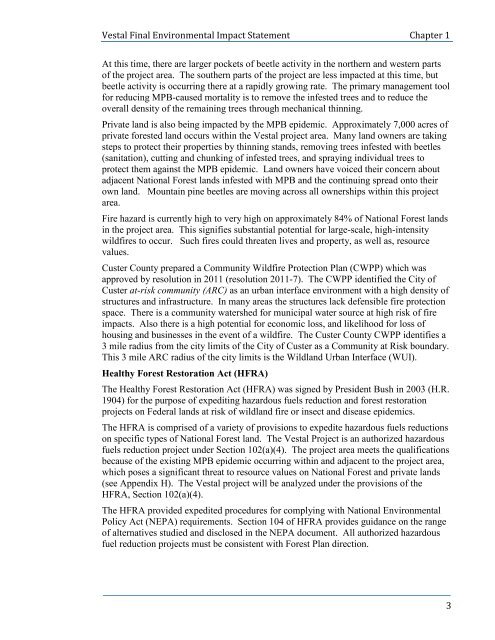Final Environmental Impact Statement
Final Environmental Impact Statement
Final Environmental Impact Statement
Create successful ePaper yourself
Turn your PDF publications into a flip-book with our unique Google optimized e-Paper software.
Vestal <strong>Final</strong> <strong>Environmental</strong> <strong>Impact</strong> <strong>Statement</strong> Chapter 1<br />
At this time, there are larger pockets of beetle activity in the northern and western parts<br />
of the project area. The southern parts of the project are less impacted at this time, but<br />
beetle activity is occurring there at a rapidly growing rate. The primary management tool<br />
for reducing MPB-caused mortality is to remove the infested trees and to reduce the<br />
overall density of the remaining trees through mechanical thinning.<br />
Private land is also being impacted by the MPB epidemic. Approximately 7,000 acres of<br />
private forested land occurs within the Vestal project area. Many land owners are taking<br />
steps to protect their properties by thinning stands, removing trees infested with beetles<br />
(sanitation), cutting and chunking of infested trees, and spraying individual trees to<br />
protect them against the MPB epidemic. Land owners have voiced their concern about<br />
adjacent National Forest lands infested with MPB and the continuing spread onto their<br />
own land. Mountain pine beetles are moving across all ownerships within this project<br />
area.<br />
Fire hazard is currently high to very high on approximately 84% of National Forest lands<br />
in the project area. This signifies substantial potential for large-scale, high-intensity<br />
wildfires to occur. Such fires could threaten lives and property, as well as, resource<br />
values.<br />
Custer County prepared a Community Wildfire Protection Plan (CWPP) which was<br />
approved by resolution in 2011 (resolution 2011-7). The CWPP identified the City of<br />
Custer at-risk community (ARC) as an urban interface environment with a high density of<br />
structures and infrastructure. In many areas the structures lack defensible fire protection<br />
space. There is a community watershed for municipal water source at high risk of fire<br />
impacts. Also there is a high potential for economic loss, and likelihood for loss of<br />
housing and businesses in the event of a wildfire. The Custer County CWPP identifies a<br />
3 mile radius from the city limits of the City of Custer as a Community at Risk boundary.<br />
This 3 mile ARC radius of the city limits is the Wildland Urban Interface (WUI).<br />
Healthy Forest Restoration Act (HFRA)<br />
The Healthy Forest Restoration Act (HFRA) was signed by President Bush in 2003 (H.R.<br />
1904) for the purpose of expediting hazardous fuels reduction and forest restoration<br />
projects on Federal lands at risk of wildland fire or insect and disease epidemics.<br />
The HFRA is comprised of a variety of provisions to expedite hazardous fuels reductions<br />
on specific types of National Forest land. The Vestal Project is an authorized hazardous<br />
fuels reduction project under Section 102(a)(4). The project area meets the qualifications<br />
because of the existing MPB epidemic occurring within and adjacent to the project area,<br />
which poses a significant threat to resource values on National Forest and private lands<br />
(see Appendix H). The Vestal project will be analyzed under the provisions of the<br />
HFRA, Section 102(a)(4).<br />
The HFRA provided expedited procedures for complying with National <strong>Environmental</strong><br />
Policy Act (NEPA) requirements. Section 104 of HFRA provides guidance on the range<br />
of alternatives studied and disclosed in the NEPA document. All authorized hazardous<br />
fuel reduction projects must be consistent with Forest Plan direction.<br />
3

















